On February 5, the day before the New England Patriots beat the Philadelphia Eagles in Super Bowl XXXIX and Paul McCartney brought a G rating back to the game’s half-time show, Frederick Douglass Pollard was voted—finally—into the National Football League Hall of Fame. “It was a shoo-in,” noted one sportswriter who was present at the vote.
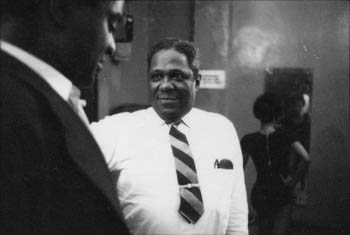
The wonder was that it took so long. Particularly for African American athletes at Brown, Fritz Pollard has long represented the victory of talent and determination over prejudice. Augustus White III ’57, a prominent surgeon and former Brown Corporation Fellow, recalls the day in 1954 when Pollard was inducted into the College Football Hall of Fame at Brown Stadium. He and teammate Archie Williams ’56 were suited up for the Bears that day, and to White “the excitement of Fritz Pollard coming back and walking the sidelines and talking to Archie and to me—that was invigorating.”
Even during the 1970s, pride in what Pollard had accomplished at Brown was still strong on Providence’s East Side. When Pollard’s grandson Fritz III enrolled at the University, the owner of one local clothing store refused to take his money: the man claimed to have already been paid in the joy he’d experienced watching Fritz Pollard play. And in 2001, while working on plans for the 125th anniversary of Brown football, former athletic director David Roach was so inspired by Pollard’s story that he teamed up with the Black Coaches Association three years later to establish the Fritz Pollard Award, which is given annually to the nation’s top African American collegiate or professional coach.
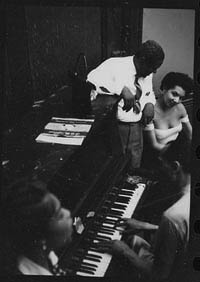
“To me, [voting Pollard into the Hall of Fame] is long overdue,” says Tony Dungy, coach of the Indianapolis Colts. “He was a pioneer, and you can’t measure that in statistics. We know a lot about Jackie Robinson. Fritz Pollard did a lot of the same things in the game of football, but we don’t know as much about him.”
Thanks to Dungy and others, Pollard’s achievements as the Jackie Robinson of football are now better appreciated; what is much less known is that football was only one small part of this remarkable man’s achievement. Even as his football career flourished, Pollard was busy establishing himself as a successful and pioneering entrepreneur. He was, successively, a dental student, a college football coach, a founder of one of the first African American–owned investment firms, the owner of a coal business, a movie actor, a founder and operator of an African American independent pro football team, a newspaper founder and owner, a syndicated sports columnist, a movie studio owner, a Negro League baseball executive, a music video producer, a talent agent, a movie producer, the founder of a public relations firm, and, finally, a tax consultant.
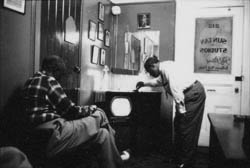
But the breadth of Pollard’s non-sports activities surpassed all of them. In the Pollard family, success was expected of everyone. “His family played a big role,” explains John Carroll, whose book Fritz Pollard: Pioneer in Racial Achievement is the definitive work on Pollard’s life and career. “They were plungers. His sister [Willie Naomi] was the first African American woman to graduate from Northwestern University. Luther [his brother] made movies and published a newspaper.” Another brother, Leslie, played football for Dartmouth and was a college football coach before his untimely death, and brother Hughes Pollard became a renowned jazz drummer before he, too, died young.
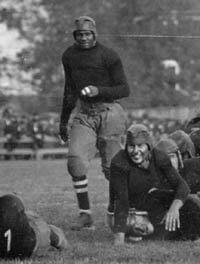
The pressing shop is also where Pollard worked with J. Mayo “Ink” Williams ’21, an African American halfback who, like Pollard, became one of Brown’s greatest players and an NFL pioneer. Williams became a “junior partner” in the pressing business (and reportedly also borrowed suits for socializing) and established a business relationship with Pollard that would last far beyond football. During summers, when students were away, Pollard took his pressing services to fashionable Narragansett Pier, a resort where black college students worked during summer break. In Narragansett, Pollard began building up his network of African American contacts; it was there, for example, that he first became friends with Paul Robeson, who, like Ink Williams, would receive occasional business propositions from Pollard during the coming decades.
After leaving Brown, Pollard studied dentistry at Penn (where he was briefly a classmate of Negro League pitcher Douglass Sheffey) while simultaneously coaching football at nearby Lincoln University. He hired Paul Robeson as his assistant, and when Pollard played pro football, Robeson soon followed him there, too.
Like a wily politician, Pollard was eager to help his friends and business partners, recognizing that he might one day need their help as well. “It’s clear,” says John Carroll, “that Pollard knew where it was possible to place people.” Pollard directly recruited Robeson to play for him when he was coach of the Akron Pros in 1921, and Robeson moved with him to the Milwaukee Badgers the following year. According to Pollard, he was the one who started Robeson on his music career by introducing him to Florence Mills at New York City’s Winter Garden Theater at around this time. She invited Robeson to perform in her floor show, and a short time later he abandoned the law and football for music.
Pollard also recruited Ink Williams to play for the NFL franchise then located in Hammond, Indiana, and eventually coached him as well. During this time both Pollard and Williams lived in Chicago, and there is evidence, according to John Carroll, that they shared an office. Ink Williams took a job with Paramount Studios (Paramount was apparently not aware of Williams’s ongoing NFL career), where he developed and recorded “race music” talent. Pollard recommended jazz great Jelly Roll Morton to Williams, who promptly signed him to a recording contract. “He didn’t know a damned thing about music,” Pollard joked, but Williams apparently learned: in 2004 the Blues Hall of Fame inducted him for his promotion of early blues greats.

While in Chicago, Pollard, along with childhood friend Charles “Chick” Evans, founded F .D. Pollard and Company, one of the first African American–owned securities firms. Evans, who was white, was a nationally known golfer who’d won the U.S. Open Championship. The high-profile company soon became successful, and Pollard began to be recognized as a conspicuously successful black businessman, with a fine home in the Chicago suburb of Evanston and a family chauffeur who, according to one account, drove him “to the railroad,” then returned “to take the children to school.”
Prosperity didn’t last, however. F. D. Pollard and Company collapsed during the Great Depression, and according to John Carroll the company may have had some financial irregularities that hastened its demise. Pollard was humiliated—and broke. He went to New York City and sought out his network of contacts for salvation. John D. Rockefeller came through for Pollard again, this time by providing a $29,000 loan. With this money Pollard started a coal business to supply Harlem residents. He also moved to Harlem himself, taking an apartment near Duke Ellington’s on exclusive Sugar Hill. Pollard soon became part of that time’s lively Harlem social scene.
The high life wasn’t always compatible with the local coal business, though. While at a party Pollard heard a woman remark, “Isn’t that the dirty coal man? How did he get invited here?” He endured the slights, however, and for years afterward took pride in the canceled check that documented his repayment of Rockefeller’s loan. This was also the period during which he again connected with Paul Robeson. Robeson, by now an internationally acclaimed actor, was making his first movie, an adaptation of Eugene O’Neill’s The Emperor Jones. Robeson asked that Pollard be added to the production staff and saw to it that his old friend had a role as a piano player. (Pollard could play a respectable piano.)
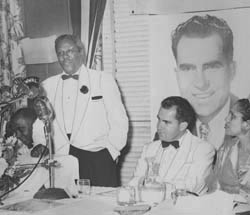
As much as they wanted to be recognized for their football skills, the Brown Bombers—named for boxing champion Joe Louis—couldn’t escape racial controversy. During their first season, instead of asking Pollard about the Brown Bombers’ five-game winning streak, reporters from the World-Telegram inquired whether African Americans had been removed from the NFL for their own protection. Despite Pollard’s strenuous efforts, no NFL team would play the Bombers, even though NFL teams of that time occasionally played independent white teams.
After the Bombers’ home field, Dyckman Oval in the Bronx, was razed in April 1938 (apparently as a result of a political dispute), Pollard gave up the team. But the point had been made. In the face of a solidifying NFL ban on African American players, and in a climate where mainstream newspapers questioned whether blacks and whites could play football together, Pollard had demonstrated in the Bombers’ game against the All-Stars that white teams could play against a black team and, in his words, “not have any trouble or prejudice.”
Pollard next began a newspaper, the New York Independent News, which he published from 1935 to 1942. Reputed to be New York City’s first African American–owned tabloid, its circulation reached as high as 35,000. Pollard began writing a sports column for the paper, Sports by Fritz, which promoted integration in professional sports and highlighted the accomplishments of African American athletes. The column survived the demise of the Independent News and eventually became syndicated in a number of African American newspapers. He would continue to write sports articles for decades.
The Independent News also served as an incubator for Pollard’s next profession: talent agent. While Pollard was publishing the paper, a friend asked to set up a studio in some of its unused offices. According to Pollard, major entertainers would come to Suntan Studios “to rehearse because they could not rehearse downtown. Duke Ellington, Cab Calloway, [Nat] King Cole, and all the big bands used to come up there to rehearse, which made my studio pretty well known.”
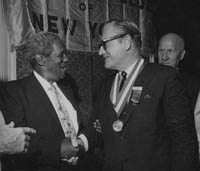
Thanks to the proximity of Suntan Studios, he was soon representing such performers as Billie Holiday, Fats Waller, Dizzy Gillespie, and Redd Foxx. After the paper went out of business, Pollard went back to contacts he’d made while working on The Emperor Jones and delved into show business with the same acumen he’d demonstrated in so many other ventures. He started by placing talent in Harlem nightclubs, but soon expanded into the rest of New York City, Philadelphia, and Atlantic City. “I’d talk to the head men, most of them acquaintances I made while playing pro ball,” he later remembered. Some would refuse to book African Americans, but Pollard wasn’t above using gangster contacts to convince them to change their minds. “That’s the way I broke the barriers down,” he reflected.
Having established a presence in the world of entertainment, Pollard branched out in 1942 to make “soundies,” three-minute films that are the forerunners of today’s music videos. Shown in such jukebox venues as bars and hotels, soundies offer a fascinating snapshot of such legendary performers as Fats Waller, Dorothy Dandridge, and Louis Armstrong. According to film historian Thomas Cripps, soundies also provided a rare opportunity for African Americans to produce their own films.
Here again Pollard drew on his extensive network of contacts. Ink Williams, now a record executive, referred talent to him, and the scarcity of other outlets probably made soundies attractive to top entertainers. In addition to Waller, Dandridge, and Armstrong, Nat King Cole, Count Basie, Duke Ellington, and Cab Calloway were also among the stars who recorded soundies. Musical numbers were rehearsed at Suntan Studios, often with production personnel that Pollard had gotten to know during his work on The Emperor Jones.
Pollard ended his involvement with soundies shortly after World War II, but ten years later he couldn’t resist one more movie production. Though a feature-length movie, Rockin’ the Blues was essentially a string of musical numbers starring previously unknown African American performers. Premiering in Harlem’s famous Apollo Theater, the film got good reviews. Pollard gave African Americans “a chance to prove themselves, to exhibit their talents,” noted one review.
By this time Pollard was well into yet another career, this one as a tax consultant. It started when a man mistakenly called his office looking for tax advice. Pollard, in his typical way, figured he knew people in the tax business, so why couldn’t he help the man? Within a few years he’d established himself as a tax expert with a roster of wealthy clients. Along with his talent agency and his sports column, Pollard continued working at it until he was well into his seventies.
Pollard succeeded in a wide array of businesses. So why didn’t he stick with any one of them? It was question Pollard sometimes asked himself. “I have often felt,” he said in an interview he granted late in his life, “I let Brown University down by not continuing to build up the businesses and opportunities” toward which Brown had launched him.
But his businesses are not as disparate as they might first appear. They shared two characteristics. They expanded the opportunities available to African Americans, either directly, as with Pollard’s foray into soundies, or indirectly, as with his late-in-life entry in the staid field of tax consulting. And all of his ventures capitalized upon his expansive list of contacts: From Ink Williams to Paul Robeson to John D. Rockefeller Jr., Pollard was able to ask for help—and get it—at crucial times in his life.
So now that Fritz Pollard is finally in the NFL Hall of Fame, it’s important not to let the achievement obscure the complex, ambitious, generous, and sly nature of a true pioneer. Racial equality for Pollard began on the football field, but it didn’t end there. After the games were over, he kept on running, demonstrating that one of the best ways to overcome racism was to personify old-time American capitalist success: to provide opportunity for those who lack it while becoming prosperous oneself. And by enjoying every minute of the ride.
Stephen Eschenbach is a writer based in Millburn, New Jersey. Brett Hoover is the assistant director of the Ivy League in Princeton, New Jersey.





